Abu Simbel and Kom Ombo
We knew it was going to be an early morning, but while 2:45am sounds bad in theory, in practice it is much, much worse. Nevertheless, we manage to drag ourselves out of bed and out to the waiting minibus for our trip to Abu Simbel. Given the dearth of tourists we have seen, we are optimistic that the two other people in the bus are going to be the only ones with us, leaving a good amount of room to stretch out and get some much needed sleep. There’s no good story in that though, and 4 stops and 30 minutes later we are packed in like sardines for a tasty three hour drive.
All traffic between Aswan and Abu Simbel has to go in conveys that leave town at specific times during the day. This is supposedly for safety reasons, but I think it really just makes it easier for the checkpoint guards to collect all of their baksheesh at a few convenient times instead of having to be awake all day and charging each car as it goes by throughout the day. We arrive close to the 3:30 convoy departure and there are already dozens of minibuses like ours and much larger coaches full of blue haired ladies, but it means we don’t have to wait that long before we are actually on the road.
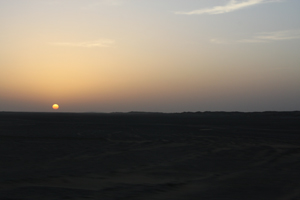 An hour or so down the road, travel buddy at my side with her head tilted back and mouth open in a quiet snore, the sun starts to rise over the desert and two thoughts come to mind as I watch. The first is that the desert is surprisingly beautiful, particularly in the early light when the colors are most vibrant. The second is that there is absolutely nothing out there. There are no cactuses, no tumbleweeds rolling by, not even a few scraggly plants eeking out a basic existence. As far as the eye can see in any direction, there is only rock and sand. Unless there are reports of Jawas in the area, the convoy is definitely overkill.
An hour or so down the road, travel buddy at my side with her head tilted back and mouth open in a quiet snore, the sun starts to rise over the desert and two thoughts come to mind as I watch. The first is that the desert is surprisingly beautiful, particularly in the early light when the colors are most vibrant. The second is that there is absolutely nothing out there. There are no cactuses, no tumbleweeds rolling by, not even a few scraggly plants eeking out a basic existence. As far as the eye can see in any direction, there is only rock and sand. Unless there are reports of Jawas in the area, the convoy is definitely overkill.
The name Abu Simbel may not ring many bells, but the temple there is something most people would recognize from pictures. Three thousand years before Mount Rushmore, Ramses II had these giant statues of himself carved into a mountainside overlooking the Nile river, serving as the entrance to a large temple hollowed out of the rock. As an added twist, the whole complex (there is also a second, smaller temple that Ramses II had built for his favorite wife, Nefertari) was moved in the 1960s to save it from the rising waters of Lake Nasser.
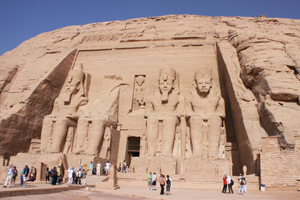
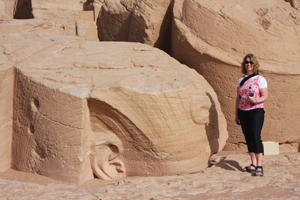
As we are restricted by the convey system, we only have a brief time in the two temples, and once again, cameras aren’t allowed inside, so we only get pictures of the entrances. By 9:00am (earlier than we would likely even be up on a regular day) we are back in the packed minivan on our way back to Aswan and the departure for our Nile cruise.
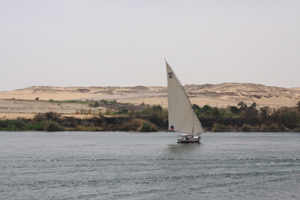 Our itinerary is to spend the next three days making our way slowly down the river to Luxor, stopping along the way to visit a few temples. Thankfully, given our early start, there is only one stop planned at the end of the day, so we are able to just relax and watch the countryside go by from our faux patio (doors, but nowhere to actually stand without ending up in the river). The boat is fairly large and there is a pool and bar on the top deck, but we just don’t have it in us to take advantage.
Our itinerary is to spend the next three days making our way slowly down the river to Luxor, stopping along the way to visit a few temples. Thankfully, given our early start, there is only one stop planned at the end of the day, so we are able to just relax and watch the countryside go by from our faux patio (doors, but nowhere to actually stand without ending up in the river). The boat is fairly large and there is a pool and bar on the top deck, but we just don’t have it in us to take advantage.
The stop we do make is at Kom Ombo, which is a temple complex changed several times over the years as different civilizations occupied Egypt. The first shoe drops on the trip we reserved in Cairo (it’s shocking that it took this long) and we find that no one has arranged a guide for us at either this stop or the one we will make tomorrow. We decide to head over anyways and read about it when we get back to the boat to try and put it in perspective.
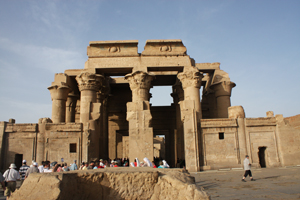 In isolation, Kom Ombo would definitely be an impressive sight, but it has been a long day, and after cramming in a lot of sights in a handful of days, one temple is starting to blur into the next, so we don’t spend too much time wandering around, taking a few pictures before heading back to the boat. On the way, I get to thinking having a couple cold beers in the fridge might be nice given the heat, so stop at one of the shops along the waterfront. They ask if we want beer, and lo and behold I do, so I say sure. I am quickly escorted to the back of the store where we conduct some business and they stuff my purchase into my backpack along with some tips on what to say to the police if they stop me. Needless to say, these may be the last two beers I buy in Egypt.
In isolation, Kom Ombo would definitely be an impressive sight, but it has been a long day, and after cramming in a lot of sights in a handful of days, one temple is starting to blur into the next, so we don’t spend too much time wandering around, taking a few pictures before heading back to the boat. On the way, I get to thinking having a couple cold beers in the fridge might be nice given the heat, so stop at one of the shops along the waterfront. They ask if we want beer, and lo and behold I do, so I say sure. I am quickly escorted to the back of the store where we conduct some business and they stuff my purchase into my backpack along with some tips on what to say to the police if they stop me. Needless to say, these may be the last two beers I buy in Egypt.
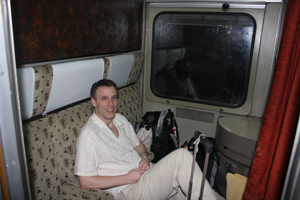 We quickly find our cabin, and are happy to see that it does only contain two bunks as promised (we have heard many stories of reservations for two berth cabins turning into four berth cabins upon arrival complete with strangers). However, that is pretty much all there is, as the cabin is no more than 5 feet across and slightly more than 6 feet long (the latter I confirm when I turn in for the night and am able to fit it perfectly). The upside is that as a night train, we will be sleeping 80% of the time anyways, so won’t miss the space much.
We quickly find our cabin, and are happy to see that it does only contain two bunks as promised (we have heard many stories of reservations for two berth cabins turning into four berth cabins upon arrival complete with strangers). However, that is pretty much all there is, as the cabin is no more than 5 feet across and slightly more than 6 feet long (the latter I confirm when I turn in for the night and am able to fit it perfectly). The upside is that as a night train, we will be sleeping 80% of the time anyways, so won’t miss the space much.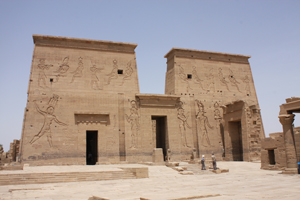
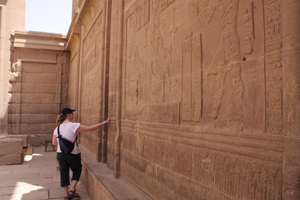
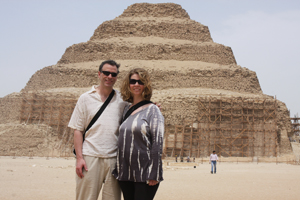 Saqqara is most well known as the place, where the first pyramid was built for the pharaoh Djoser, by his architect Imothep (who despite some bad PR in The Mummy, was pretty famous in his own right). This pyramid is known as the Step Pyramid, as it was built as a series of small square platforms on top of one another rather than the straight-sided versions that came later. The pyramid itself was part of a large complex of buildings, such as temples the pharaoh would use in his afterlife, and tombs for the nobility of the time, who were allowed to be buried near the pharaoh. A handful of later pharaohs also built their pyramids at Saqqara, although at a time when Egypt was waning in wealth and power, so none of them were equal in size to the Step Pyramid and attract little attention.
Saqqara is most well known as the place, where the first pyramid was built for the pharaoh Djoser, by his architect Imothep (who despite some bad PR in The Mummy, was pretty famous in his own right). This pyramid is known as the Step Pyramid, as it was built as a series of small square platforms on top of one another rather than the straight-sided versions that came later. The pyramid itself was part of a large complex of buildings, such as temples the pharaoh would use in his afterlife, and tombs for the nobility of the time, who were allowed to be buried near the pharaoh. A handful of later pharaohs also built their pyramids at Saqqara, although at a time when Egypt was waning in wealth and power, so none of them were equal in size to the Step Pyramid and attract little attention.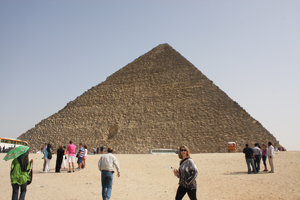 We arrive at Giza at little after 1pm, and despite seeing the pyramids for two days already from our balcony, nothing could prepare us for seeing them up close. They are simply massive, and as we walk around them listening to our guide talk about the history, I can’t stop staring, trying to imagine how the ancient Eqyptians could have possibly built something of this scale. Mohamed reminds us that the pyramids at Giza were built around 2500 B.C., so that by the time the Chinese were building the Great Wall, the buildings I am staring at had already survived over two thousand years.
We arrive at Giza at little after 1pm, and despite seeing the pyramids for two days already from our balcony, nothing could prepare us for seeing them up close. They are simply massive, and as we walk around them listening to our guide talk about the history, I can’t stop staring, trying to imagine how the ancient Eqyptians could have possibly built something of this scale. Mohamed reminds us that the pyramids at Giza were built around 2500 B.C., so that by the time the Chinese were building the Great Wall, the buildings I am staring at had already survived over two thousand years.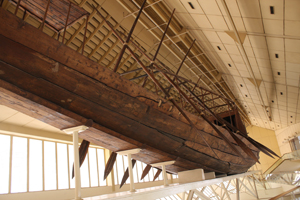 Behind the pyramid of Khufu, there is a separate museum built specifically to house a wooden boat that was excavated from a pit near his tomb. Rebuilt, the boat measures over 140 feet in length and is made of cedar, which remains in excellent condition even 4,500 years later. Designed for the pharaoh to use in the afterlife, the boat was never actually put into water, but instead was constructed, disassembled, and stored in a pit carved into the limestone, and then covered with a series of huge limestone blocks.
Behind the pyramid of Khufu, there is a separate museum built specifically to house a wooden boat that was excavated from a pit near his tomb. Rebuilt, the boat measures over 140 feet in length and is made of cedar, which remains in excellent condition even 4,500 years later. Designed for the pharaoh to use in the afterlife, the boat was never actually put into water, but instead was constructed, disassembled, and stored in a pit carved into the limestone, and then covered with a series of huge limestone blocks.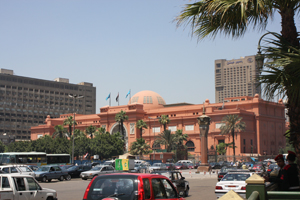
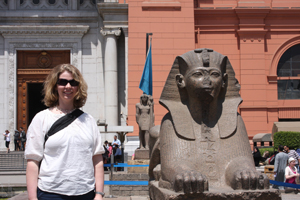
 Our hotel for the next two nights is in Giza, directly across the street from the pyramids and we luck out with a room facing that direction. Since we arrived close to 4pm, it is still plenty light enough to see them towering in front of us directly from our balcony. Definitely one of the most impressive views we have ever had, and a great way to start our time here. At night, they light them up a bit, which makes for a fairly impressive sight.
Our hotel for the next two nights is in Giza, directly across the street from the pyramids and we luck out with a room facing that direction. Since we arrived close to 4pm, it is still plenty light enough to see them towering in front of us directly from our balcony. Definitely one of the most impressive views we have ever had, and a great way to start our time here. At night, they light them up a bit, which makes for a fairly impressive sight.